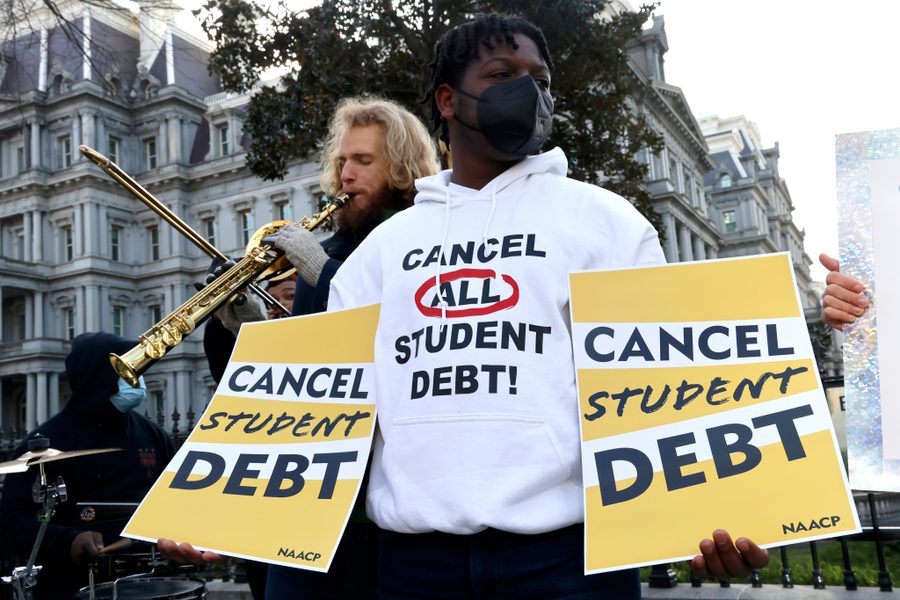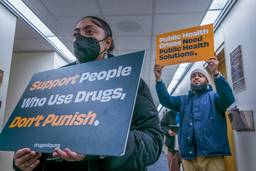Youth to Biden: Drop Debt
Democrats may be doomed in the midterms without student debt cancellation.
Paige Oamek

President Joe Biden extended the pause on student loan payments and interest in December 2021 as Omicron spread, a forbearance that began under the Trump administration in 2020. Yes, the delay is a win for those crushed by a cumulative nearly $2 trillion in student debt, but it also fails to truly address the debt, a pressing issue for more than 40 million Americans.
To prevent a blowout in this year’s midterm elections, Democrats must make transparent their plan for student debt forgiveness and deliver a tangible win for my generation.
On the 2020 campaign trail, Biden repeatedly claimed he would support $10,000 of student debt forgiveness, which “should be done immediately.” He had rejected more (as proposed by some primary challengers), saying, “I don’t think I have the authority to do it.”
But Suzanne Kahn, managing director of research and policy at the Roosevelt Institute, says Biden does have the authority, even without Congress: “[Biden] has the authority to direct the secretary of Education to at least cancel all of the student debt held by the federal government, which is about 95% of the student debt out there.”
In April 2021, Biden asked Secretary of Education Miguel Cardona to prepare a memo about his powers to cancel student debt. In October 2021, the New Yorker reported that, thanks to a Freedom of Information Act request from the debtors’ union Debt Collective, we know there is an update from the Department of Education — we just don’t know what it says. The memo, titled “The Secretary’s Legal Authority for Broad-Based Debt Cancellation,” was heavily redacted in millennial pink.
Unsympathetic austerity politicians will try to pit Americans against each other by painting the student debt crisis as a nonissue for working people. Rep. Dan Crenshaw (R Texas), for example, called the “cancel student debt” movement “nakedly corrupt,” a scheme “to bribe elites who hold expensive graduate degrees.” Biden himself has pushed this narrative in an odd way saying he’s concerned about forgiving debt for students from “Harvard and Yale and Penn”.
But student loan regressivity is a myth. A brief by the Roosevelt Institute puts it this way: “Debt cancellation leads to the highest reductions in the debt-to-income ratio for people with the lowest incomes.” After all, nearly 40% of borrowers never even received a degree.
A 2021 survey from the Student Debt Crisis Center found that 89% of fully employed student loan borrowers can’t afford their payments in February; 20% said they will never be financially secure enough to resume payments; and 27% said “one-third of their income or more” goes to student loans. As early pandemic protections fall away (such as the child tax credit, federal jobless aid and the eviction moratorium), the threats are compounding. According to a Federal Reserve of New York survey, 28% of Americans say they are “somewhat” or “much worse off” than a year ago.
The population of student loan borrowers is a core of the Democratic base — young people with some post-secondary education. This is a generation who, in the face of Covid-19 and an impending second Trump term, mobilized for Biden. Youth voter turnout climbed 8% over 2016, with more than half of all eligible young people voting. Among Gen Z voters, 65% went for Biden, 11% more than any other age group.
The Dems cannot keep delaying meaningful action and expect our votes. According to data from YouGov and the Economist, Biden’s approval rating among those younger than 30 has plunged 50 points since Inauguration Day. This administration threatens to be defined by its inability to deliver wins for working people.
Meanwhile, loan payments are set to resume May 2 — one day after International Workers’ Day. Let’s get organized.
Paige Oamek is a writer and fact-checker based in New York. Their writing appears in The Nation, The American Prospect and elsewhere.









